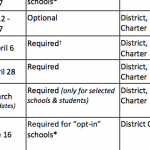Can Testing Save Art Education?
Scott Sikkema’s response to The Hechinger Report’s “Can Testing Save Art Education?”
The Hechinger Report’s “Can Testing Save Arts Education?” implies for the reader that arts administrators (from state and city/boards of education, external arts providers, and consultants) and some classroom arts educators themselves are demanding some kind of standardized testing format for the arts. The current emphasis on standardized arts testing ignores a basic tenet of assessment, which is that assessment is impactful on teaching and learning when it is designed or comes from the individual teacher for her/his individual classroom and particular group of students (sometimes termed local assessment). Standardized tests are not about the individual student; standardized tests are short-term audits for sorting purposes towards large, general inferences. If those same arts education administrators want standardized arts testing, they must clearly articulate why they want a temporal audit for what sorting purposes towards what kind of large inference–and, again, why do they want or need this inference. I have yet to see that argument be made. Arguing for arts testing as a way to demonstrate art is equal in importance to math is not a valid or thought-out reason that has anything to do with teaching or learning. It’s only a marketing strategy.
The article comes from the viewpoint that the arts have nothing to contribute to assessment, but instead can only take or borrow from a kind of vague idea about standardized tests. This is false as a supposition, beginning first with the notion of standardized testing for individual arts classrooms. Standardized tests are simply not an effective model for in-classroom assessment, and, in fact, do not purport to be such a model for specific classrooms. As Grant Wiggins writes, “…traditional large-scale testing causes teachers to mimic locally the format of test items, even though such mimicry turns validity on its head and lowers intellectual standards over time.” In addition, standardized tests have no greater proof of accuracy; as James Popham observes, “although it is widely believed that large-scale educational tests are remarkably accurate, they are much less precise than what is thought.” (I would also like to add here that many arts administrators are putting forward a lot of fantastical notions about what math and science educators believe and do as regards assessment. I find this striking when I attend meetings with math or science educators, and hear them put forward progressive and innovative ideas about assessment that would seem radical to these same arts administrators.)
The arts, instead, have much potential to contribute to the discussion of the role of local, or individual, assessment via such approaches as portfolios, performance tasks, interviews, observations, and critique. Such approaches get at areas of student development of meta-cognition, or non-cognitive factors. This is what should be fought for, not hand-wringing over trying to make a compromised, pseudo-standardized assessment, based on needs extraneous to teaching and learning.
The emphasis here in the article, which is common, is on summative testing, or summative assessment, for arts learning. To discuss only summative assessment misleads the reader as to the questions and issues around how arts learning is developed and articulated, both for the learner and the instructor. Formative assessment, which is not looked at in the article or in these testing debates, often shows to be more effective on impacting instructional strategies and on students’ positively changing their approach to whatever it is they are working on. Good formative assessment is almost always very individual to the classroom. Good formative assessment also clearly serves the learner as well, an important aspect of assessment that is rarely discussed in conversations around standardized arts testing.
The shadow of No Child Left Behind still looms over this debate about testing and assessment. NCLB discouraged local assessments and created an illusion that standardized testing could be used as a classroom-based assessment. NCLB also helped engender a dynamic where any challenge voiced from the arts contrary to these notions around standardized testing is viewed as weak, or “anti-rigor.” We must reject this closure to contrary viewpoints. Instead, we should engage in conversations that draw on the expertise of classroom-based arts teachers, university-based arts education instructors, and independent artists, where they share their current approaches to assessment and envision new possibilities.





